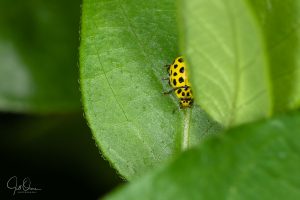Though it’s one of our smallest ladybirds, at 3.5-4.5mm in length, the 14-spot is a voracious predator of aphids. The swarm of aphids on my yarrow plants seems to have defeated the larger 7-spots and harlequins, which have now abandoned this flower bed, but there are still two 14-spots there, methodically working their way up and down the stems like tiny Terminators, and leaving a trail of discarded legs and wings in their wake.
14-spot ladybirds are most easily recognised by the square shape of their spots. Their ground colour can be anything from palest cream to orange, and the pronotum may be paler than the wing cases as it is here, but the spots are always black. The fusion of spots can be much more extensive than in this individual; in particular, the two spots either side of the midline often join into a bar, which together with the dark midline and the curve of fused spots at the far end of the elytra, forms a distinctive anchor marking. In some specimens the black spots are so enlarged and fused that it looks as though the colours have been reversed completely.
The bright colouring of the 14-spot ladybird is a signal to potential predators that it’s unpalatable. If it is attacked, it can ‘bleed’ a pungent yellow fluid from its joints as a further deterrent. Each female ladybird will lay up to ten batches of forty eggs; the larvae suffer a high mortality rate, but those that survive are also effective predators. Adults can be seen between May and October, when they go into a long hibernation – according to Wikipedia they overwinter twice, which suggests that the species is unusually long-lived, but I haven’t seen this information repeated anywhere else.
For contrast and comparison, tonight’s extra is another ladybird. The 22-spot is even smaller, at 3-4mm in length, and is a brighter yellow than the 14-spot, with rounder spots that are rarely fused (though on this specimen they look a little smudged). The pronotum can be white, but this is the only real variation you’re likely to see. Unusually for a ladybird, this one isn’t carnivorous, but is mycophagous, feeding on mildew on the surface of leaves or soil.
This has been a good year in my garden for 22-spot ladybirds, possibly because this summer’s strange weather has caused quite a few plants to develop mildew. In particular there are several feeding on my honeysuckle vines at the moment, and I’ve noticed that they’re quite sedentary – I’ve photographed this one in almost the same spot on several occasions now. The other day I did see one relocate, and it accidentally flew into the web of a small garden spider, where I assumed that it was about to come to an unpleasant end – I’ve watched garden spiders eat 7-spot ladybirds in the past, and it’s not a pretty spectacle. The spider rushed towards the ladybird and touched it with a couple of legs, but then literally turned tail and fled, back out to the edge of its web. I can only assume that it had tried a yellow ladybird before and found it repulsive, and that the distinctive livery of the 22-spot was enough of a reminder to make it rapidly rethink its lunch plans.








